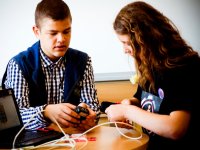22 Powerful Closure Activities
Quick activities that can be used to check for understanding or emphasize key information at the end of a lesson.
Your content has been saved!
Go to My Saved Content.Closure refers to an activity that ends a lesson and creates a lasting impression, a phenomenon called the recency effect. Administrators may criticize lessons that lack closure, a criticism likely arising from improper use of Madeline Hunter’s lesson plan model (PDF) as a de facto checklist of eight mandatory teaching practices—anticipatory set, objective and purpose, input, modeling, checking for understanding, guided practice, independent practice, and closure. Hunter herself decried this criticism in 1985 (PDF).
Closure offers multiple benefits, but please don’t view it as a professional must-do in every lesson.
Teachers use closure to:
- Check for understanding and inform subsequent instruction,
- Emphasize key information,
- Tie up loose ends, and
- Correct misunderstandings.
Students find closure helpful for:
- Summarizing, reviewing, and demonstrating their understanding of major points,
- Consolidating and internalizing key information,
- Linking lesson ideas to a conceptual framework and/or previously learned knowledge, and
- Transferring ideas to new situations.
Like contracting your bicep at the top of a dumbbell curl, closure squeezes an extra oomph into a lesson.
Creative Closure Activities
1. Snowstorm: Students write down what they learned on a piece of scratch paper and wad it up. Given a signal, they throw their paper snowballs in the air. Then each learner picks up a nearby response and reads it aloud.
2. High-Five Hustle: Ask students to stand up, raise their hands and high-five a peer—their short-term hustle buddy. When there are no hands left, ask a question for them to discuss. Solicit answers. Then play “Do the Hustle” as a signal for students to raise their hands and high-five a different partner for the next question. (Source: Gretchen Bridgers)
3. Parent Hotline: Give students an interesting question about the lesson without further discussion. Email their guardians the answer so that the topic can be discussed over dinner.
4. Two-Dollar Summary: Kids write a two-dollar (or more) summary of the lesson. Each word is worth 10 cents. For extra scaffolding, ask students to include specific words in their statement. (Source: Ann Lewis and Aleta Thompson)
5. Paper Slide: On paper, small groups sketch and write what they learned. Then team representatives line up and, one at a time, slide their work under a video camera while quickly summarizing what was learned. The camera doesn’t stop recording until each representative has completed his or her summary.
6. DJ Summary: Learners write what they learned in the form of a favorite song. Offer extra praise if they sing.
7. Gallery Walk: On chart paper, small groups of students write and draw what they learned. After the completed works are attached to the classroom walls, others students affix sticky notes to the posters to extend on the ideas, add questions, or offer praise.
8. Sequence It: Students can quickly create timelines with Timetoast to represent the sequence of a plot or historical events.
9. Low-Stakes Quiz: Give a short quiz using technologies like Socrative, GoSoapBox, or Google Forms. Alternatively, have students write down three quiz questions to ask at the beginning of the next class.
10. Cover It: Have kids sketch a book cover. The title is the class topic. The author is the student. A short celebrity endorsement or blurb should summarize and articulate the lesson’s benefits.
11. Question Stems: Have students write questions about the lesson on cards, using question stems framed around Bloom’s Taxonomy. Have students exchange cards and answer the question they have acquired.
12. So What?: Have students answer this prompt: What takeaways from the lesson will be important to know three years from now? Why?
13. Dramatize It: Have students dramatize a real-life application of a skill.
14. Beat the Clock: Ask a question. Give students 10 seconds to confer with peers before you call on a random student to answer. Repeat.
15. Teach a First-Grade Student: Have kids orally describe a concept, procedure, or skill in terms so simple that a child in first grade would get it.
16. Review It: Direct kids to raise their hands if they can answer your questions. Classmates agree (thumbs up) or disagree (thumbs down) with the response.
17. CliffsNotes Jr.: Have kids create a cheat sheet of information that would be useful for a quiz on the day’s topic. (Source (PDF): Ann Sipe, “40 Ways to Leave a Lesson”)
18. Students I Learned From the Most: Kids write notes to peers describing what they learned from them during class discussions.
19. Elevator Pitch: Ask students to summarize the main idea in under 60 seconds to another student acting as a well-known personality who works in your discipline. After summarizing, students should identify why the famous person might find the idea significant.
20. Simile Me: Have students complete the following sentence: “The [concept, skill, word] is like _____ because _____.”
21. Exit Ticket Folder: Ask students to write their name, what they learned, and any lingering questions on a blank card or “ticket.” Before they leave class, direct them to deposit their exit tickets in a folder or bin labeled either “Got It,” “More Practice, Please,” or “I Need Some Help!”—whichever best represents their understanding of the day’s content. (Source: Erika Savage)
22. Out-the-Door Activity: After writing down the learning outcome, ask students to take a card, circle one of the following options, and return the card to you before they leave:
- Stop (I’m totally confused.)
- Go (I’m ready to move on.)
- Proceed with caution (I could use some clarification on _____.)
Download the PDF cards for this exercise.
These 22 strategies can be altered or blended very effectively. And they are great opportunities to correct, clarify, and celebrate.
